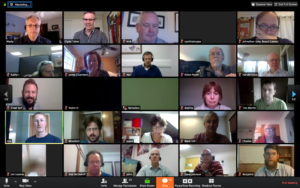The Mobile Ministry Forum held it’s fourth webinar of the year with more than 50 people joining us from places as diverse as South Sudan, Holland, North Ireland, Bosnia, Ethiopia, Australia, and Southern California.
The 10 Ideas
View the webinar recording for more details.
- Mobile Ministry Made Easy Guide is now available in Filipino and Russian versions.
- The Digital Ministry Atlas gives a detailed overview of the digital terrain in 40 least-reached countries.
- “Mobile is Everywhere” is a slidedeck you can use to promote using mobiles in ministry.
- Renew is developing a $50 version of its Lightstream.
- The Gospel Resource Index Prototype allows a user to search for all the content available for that language. The full version will be available in 2017.
- The 2017 Mobile Ministry Forum Consultation will be April 7-8 in Zelhelm, Holland, in April is open for registration. We encourage you to consider the EMDC conference on April 3-6 as well.
- The Your Phone-God’s Glory curriculum has new video tutorials.
- Scripture App Builder, Reading App Builder and Dictionary App Builder are available. You get three for the price of one on this!
- 12 Ways to Prep Your Short-Term Mission Team is updated.
- MMF has a SLACK channel. Email elizabeth@visualstory.org if you would like to be invited to join.
More Resources (Comments From the Chat)

Allan: Attention BibleBox users: WR842ND routers can still be purchased inexpensively from a supplier in Canada. If you buy four at once it currently comes out to $27 each (they charge a flat $6 shipping fee for 1-4 units). More info.
Brian: A dedicated Bible app using the Sharif Arabic translation will be available soon. This can be used and distributed offline. It should be available for both Android & iOS. Email greatcommworkers@gmail.com for more info.
Darcie: The Reading App Builder has a neat feature to pan and zoom the images. Turn your screen in landscape mode and the text appears phrase by phrase, synchronized with the audio. VERY cool!
Brandon: They also just implemented an “offline sharing” phone to phone share button on the Scripture app.
Allan: SAB is currently also being used to develop a language diagnostic tool for Mexico ―there are 300 language variants with resources available and sometimes dozens of languages from the same family, so this is very helpful.
Darcie: Gitden Reader can read ePub files built with SAB or RAB.
Darcie: I have Gitden Read on my iPhone
Brian: I mentioned the Sharif Bible app above. If you know of people working with Syrian refugees, this is the translation that seems to be most requested. It will be ideally suited for outreach as it contains just a single translation and will look Arabic rather than Western.
John: We (FCBH) have the audio and you can get a free API from us to pull in the audio content. API Access is at http://digitalbibleplatform.com/
Johnathan: American Sign Language Bible Telegram Chat Bot.
Mark: www.TheStoryFilm.com
Brian: If anyone knows of folks in the L.A. area, there will be a great 1-day conference coming up Nov 19 called UPG-Tech with a focus on using mobiles & other tech to reach unreached people groups. A few of us here on the call will be there.
Mark: Finishing the Task Conference is December 6-8 at Saddleback Church.
_________________________________________________________

Hello,
To paraphrase Paul (1 Cor. 14:9), “if technology makes a message unintelligible to some people, how will they know what is being said?”
I am introducing the book Turning Barriers Into Bridges: The Inclusive Use of Information and Communication Technology for Churches in America, Britain, and Canada, by Dr. John Jay Frank.
Whenever churches or missions groups misuse information and communication technology (ICT) a large number of people cannot participate fully or at all. More than 100 million people in America, 17 million in Canada, 17.2 million in the United Kingdom. and more than 1.5 billion people worldwide cannot see, hear, or read well. Most can see, hear, or read somewhat, if technology does not get in the way. This 114 page book will help churches better fulfill the Great Commandments and the Great Commission.
Turning Barriers Into Bridges is not about a special outreach or a unique disability ministry, or a new cause, or civil rights, nor is it about buying new equipment . It describes why and how we can set up church, missions, and evangelize at all times, using the ICT we already own so that more people can participate without needing to make special requests.
The Preface, Table of contents and Introduction can be read by clicking on the picture of the book at: http://www.minstrelmissions.com. The View More tab leads to the amazon.com page. The book is available in a Kindle ebook version, and paperback in standard 12 point Arial print, or in 18 point Arial, large print, from amazon.com or Ingram.
Thank you for reading and if you wish, reviewing this book.
I look forward to comments and questions you, your colleagues, or students care to share, even if to just let me know you received it.
A Reading / study guide and Technology Accessibility Audit are below
John Jay Frank, Ph.D.
814 Dobbin Drive, Kalamazoo, MI 49006
II Kings 3:15, Website: http://www.minstrelmissions.com
e-mail: minstrelmissions@gmail.com
Reading / study guide for Turning Barriers Into Bridges
1) Front and back cover, Preface, Table of Contents
and Introduction, chapter 1.
2) Bible section, chapters 2 and 3.
3) Secular law section, chapter, 4 and 5.
4) Cultural conflicts, chapters 6 and 7.
5) Common reasons offered for not being accessible, chapter 8.
6) Demographics, America, Britain, Canada, and the World, chapter 9.
7) Remedies, chapter 10 and 11.
8) References, chapter 12, About the Author, page 107.
Accessibility Audit of Church Use of
Information and Communication Technology
1. Printed material generally distributed to individuals or families.
2. Computer projection of lyrics, outlines, scripture, notices.
3. Evangelistic and missions materials and technology.
4. Signs (permanent and occasional announcements).
5. Books (especially Bibles, hymnals, song, lesson, or in a church library).
6. Internet (Website, social media, general communications).
7. Sound systems (aids for people for hearing and decibel levels).
8. Video (audio narration and print descriptive captioning).
9. Tactile writing (Braille) or audio alternatives.
10. Sign language interpretation in person or Online, TDD phone.
11. Knowledge and attitudes of members, leaders, and staff about
accessibility for people who do not see, hear, or read well.
12 Knowledge of available resources for accessibility.
Note: Technology is a large area by itself. Other barriers exist, such as architectural issues. Those can be a separate accessibility book and audit.
If no other department teaches ICT accessibility, let yours be the first!
* * * * * * * *
In addition to music samples on the Website, clicking on the picture of each book opens up a .pdf sample of the Preface, Table of Contents, and Introduction. There are also six music videos from the DVD on YouTube found by entering in the search box: kE19hkrt1IQ or 0bdysB0THXs or gOylQLBtz90 or p4proXRKLr0 or 6yAMjCGan2I or QGG8ebFmk7A
Enjoy!
John, Thanks for letting us know about this.
Here is a site with some helpful info for about 8- 10 percent of the population and at times, even the other 90 percent as well. There is a video demo on this site.
>How to Design iOS Buttons that Pass Color Contrast.https://www.deque.com/blog/how-to-design-ios-buttons-that-pass-color-contrast/ General > Accessibility > Increase Contrast. The Darken Colors setting should be the second item on this page (after Reduce Transparency). If you turn it on, you will immediately see the Back Button in the top left corner change to a darker color. This is the expected behavior for this setting, and the behavior that you want in your app.
In order to take advantage of this accessibility setting, we have to do some code.
First, in your ViewController class, create some IBOutlets for the views that you want responding to the Darken Colors setting (if you have not already). In this case, I want the text color of my iOS Button to change when Darken Colors is on.
Conclusion
Changing colors might be a small change, but it is a great help for many people, especially as people age. Eight to ten percent of the population has some sort of color blindness, so the more you can to do help, the better.